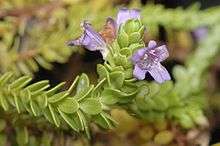Eremophila ternifolia
| Wongan eremophila | |
|---|---|
 | |
| Scientific classification | |
| Kingdom: | Plantae |
| (unranked): | Angiosperms |
| (unranked): | Eudicots |
| (unranked): | Asterids |
| Order: | Lamiales |
| Family: | Scrophulariaceae |
| Genus: | Eremophila |
| Species: | E. ternifolia |
| Binomial name | |
| Eremophila ternifolia Chinnock[1] | |
Eremophila ternifolia, commonly known as Wongan eremophila[2] is a flowering plant in the figwort family, Scrophulariaceae and is endemic to Western Australia. It is a low, many-branched, shrub with short, pointed leaves and small lilac-coloured or mauve flowers.
Description
Eremophila ternifolia is a spreading, aromatic, many-branched shrub which grows to a height of between 30 and 50 cm (10 and 20 in). Its branches are hairy with both simple and shorter glandular hairs. The leaves are arranged in whorls of three, clustered and overlapping each other near the ends of the branches. They are elliptic to lance-shaped, 6–11 mm (0.2–0.4 in) long, 2.5–4.0 mm (0.1–0.2 in) wide, glabrous, light green in colour but often reddish-brown on the lower side.[2][3]
The flowers are borne singly in leaf axils and lack a stalk. There are 4 or 5 green to reddish-brown, linear to narrow triangular, hairy sepals which are 3–4.6 mm (0.1–0.2 in) long. The petals are 8–10 mm (0.3–0.4 in) long and are joined at their lower end to form a tube. The petal tube is lilac-coloured or mauve on the outside and white with purple spots inside. The outer surface of the tube and lobes is hairy but the inner surface of the petal lobes is glabrous and the inside of the tube is filled with long, soft hairs. The lower petal lobe is also hairy. The 4 stamens are fully enclosed in the petal tube although the upper pair are almost the same length as the tube. Flowering occurs from October to November and is followed by fruits which are dry, woody, oval-shaped with a pointed end and about 2–3 mm (0.08–0.1 in) long with a hairy covering.[2][3]
Taxonomy and naming
This species was first formally described by Robert Chinnock in 1982 and the description was published in Nuytsia.[1] The specific epithet (ternifolia) is derived from the Latin words terni meaning "three at a time"[4] and folia meaning "leaves"[5] referring to the arrangement of the leaves.[3]
Distribution and habitat
This eremophila is restricted to the Wongan Hills[3] in the Avon Wheatbelt biogeogaphic region where it grows in rocky situations.[6]
Conservation
Eremophila ternifolia is classified as "Threatened Flora (Declared Rare Flora — Extant)" by the Department of Environment and Conservation (Western Australia).[6] It is listed as "Endangered" under Commonwealth legislation. Surveys between 1999 and 2001 recorded the total population as 1381 plants.[7]
Use in horticulture
In cultivation, this small shrub has a dense, circular shape with a flat top and it would be an ornamental feature in a small garden. It is long-lived in gardens, some specimens are over 25 years old, and it has attractive lilac-coloured flowers among leaves which sometimes have a reddish-brown tinge. Propagation is usually from cuttings and the shrub grows well in most soil types in a sunny or partly shaded position, is drought tolerant and very frost hardy.[8]
References
- 1 2 "Eremophila ternifolia". APNI. Retrieved 22 March 2016.
- 1 2 3 Brown, Andrew; Buirchell, Bevan (2011). A field guide to the eremophilas of Western Australia (1st ed.). Hamilton Hill, W.A.: Simon Nevill Publications. p. 274. ISBN 9780980348156.
- 1 2 3 4 Chinnock, R.J. (Bob) (2007). Eremophila and allied genera : a monograph of the plant family Myoporaceae (1st ed.). Dural, NSW: Rosenberg. pp. 252–254. ISBN 9781877058165.
- ↑ "terni". Wiktionary. Retrieved 28 February 2016.
- ↑ "folium". Wiktionary. Retrieved 28 February 2016.
- 1 2 "Eremophila ternifolia". FloraBase. Western Australian Government Department of Parks and Wildlife.
- ↑ "Approved Conservation Advice for Eremophila ternifolia (Wongan Eremophila)" (PDF). Australian Government, Department of the Environment. Retrieved 22 March 2016.
- ↑ Boschen, Norma; Goods, Maree; Wait, Russell (2008). Australia's eremophilas : changing gardens for a changing climate. Melbourne: Bloomings Books. pp. 224–225. ISBN 9781876473655.
